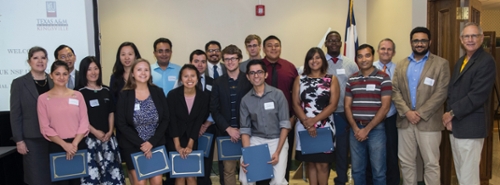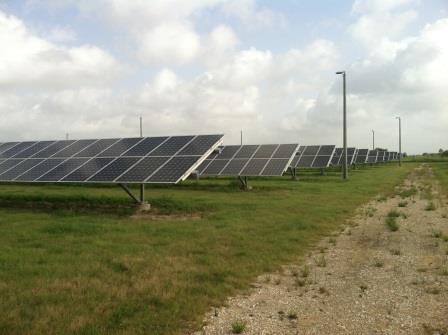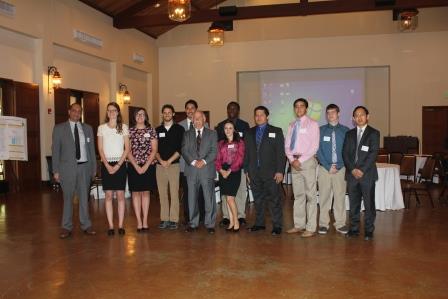National Science Foundation - REU Summer Program
Summer 2017 IR-SEED NSF-REU program Application Information
June 4, 2017 to August 11, 2017
Download Summer 2017 Program Flyer from here
Download Summer 2017 Program Application Form from here
Download Summer 2017 Program Research Projects from here
Application Deadline: March 6, 2017
REU Site: Integrating Research in Sustainable Energy and the Environment across Disciplines
(IR-SEED)
Summer 2017 IR-SEED REU Program: June 4 to August 11, 2017
1. Innovative Improvement of Engineering Properties of Expansive Soils with Nanomaterials
(Faculty Advisor: Dr. Jong-Won Choi, Assistant Professor in Civil & Architectural Engineering)
One of the key concerns in geotechnical engineering is mitigation of detrimental impacts of expansive soils on geotechnical structures. Conventional approaches such as chemical stabilization with cementitious materials have been in extensive use for decades, but they give rise to various environmental issues. Recently, advances in nanotechnology have presented new opportunities to reinforce expansive soils and have been exhibiting noticeable success. However, current understanding of fundamental stabilization mechanism with nanomaterials is very limited, blocking advancement toward intelligent use of nanomaterials in geo-engineering. This research project will explore fundamental mechanism of nanomaterials in reinforcing expansive soils, which will form the basis of developing a general framework to predict material properties of reinforced soils with nanomaterials.
The goal of this research project is to (1) gain the insight into the mechanism of nanomaterials in the improvement of material properties of expansive soils in terms of the material type and the amount of nanomaterials for reinforcement and to (2) develop general principles to elucidate properties of reinforced soils, which will provide a predictive power over the behavior of the soils in response to external loading.
2. The effect of fenestration system on building energy and daylighting performance – An experimental study
(Faculty Advisor: Dr. Xiaoyu Liu, Assistant Professor in Civil & Architectural Engineering)
i. Motivation: Modern buildings tend to have large glass facades on different orientations for good outdoor view and daylight utilization. Compare to traditional masonry wall construction, the lower thermal resistance values can result in increased heat losses (and solar gains) and hence reduce the efficiency of modern transparent facades. The balance between daylighting benefits and energy requirements should be investigated in details for optimizing the design of modern fenestration systems.
ii. Project Description: This project investigates the impact of fenestration system design on energy and daylighting performance of modern buildings through extensive experimental studies. The following activities describe the tasks needed to achieve the objective and bridge the research gaps previously mentioned.
Task 1: Review thermal and visual characteristics of modern fenestration systems. There are numerous of fenestration products available from current market with various properties in terms of thermal and visual performance. To achieve the optimal fenestration option for a specific building, it’s critical important to understand how these properties affect heat transfer and light transmission between indoor and outdoor. In this task, the professional tool WINDOW will be used to collect detailed information of products and identify two products to be used in real-time measurement in the next task.
Task 2: Experimental setup. Two test cells (1.8m × 1.8m × 2.4m) with reconfigurable fenestration system were built at TAMUK Architectural Engineering lab. They are insulated and airtight such that satisfy the International Energy Conservation Code (IECC). There is a window on one wall of each test cell respectively. The test cells are sitting on wheels so that the window can face any orientation as needed. Identified products will be installed and their performance be measured comparatively. Students will instrument the test cells, design and conduct experiments to collect extensive data on energy performance and daylighting performance of test cells installed with different fenestration systems, with consideration of different orientations, window sizes and window positions in the wall.
Task 3: Measured data analysis. The effect of fenestration system on energy and daylighting performance will be analyzed from two aspects: heat transferred and light transmitted through the window. Conclusions will be drawn and extended to other climate locations.
iii. Undergraduate Research Opportunities: Undergraduate students will participate and learn during the whole period of the proposed project. Expected learning experiences include 1) hands-on experimental skills; 2) professional software operation; and 3) data analysis and presentation skills. The students will also participate in the dissemination activities.
3. Vehicle Interior Air Quality Analysis
(Faculty Advisor: Dr. Xiaoyu Liu, Assistant Professor in Civil & Architectural Engineering)
i. Motivation: Air quality plays an important role in occupational space and many airborne factors have adverse effects on human health. The health significance of Volatile Organic Compounds (VOCs) receives more and more attention. There have been numerous studies of the types and levels of VOCs in buildings. However, limited research works have been done within the interior cabins of vehicles. The environment of the vehicle is a microcosm of the indoor environment and is thus potential susceptible to VOCs, which come from the materials, finishes used in car interiors and exhaust fumes occasionally. And many people spend around an hour each day in enclosed vehicles. Studying the vehicle indoor air quality is urgently needed. Unlike the inside of buildings, the vehicles are exposed to various outdoor conditions. The vehicle interior environment is affected by outdoor environment heavily. Various outdoor conditions will dramatically affect the concentration of VOCs. For example, the high air temperature inside cars can greatly increase the concentration of VOCs and break other chemicals down into more toxic constituents. This project will study the vehicle interior air quality by performing field tests. Through tests and data analysis, key affecting factors of VOCs will be identified and quantified.
ii. Project Description: The objective of this research project is to identify the key factors affecting the concentration of VOCs inside of cars and quantify the effects. Specifically, the following activities describe the tasks required to achieve the objective and bridge the research gaps previously mentioned.
Task 1: Perform literature review to collect information of vehicle interior air quality. In this task, a literature review will be conducted. This task is committed to summarize recent studies that address the air pollution sources which will affect human health in the vehicles. This task will also organize the methods applied to analyzing building indoor and vehicle interior air quality. In this task, potential affecting factors of VOCs will be identified.
Task 2: Perform field tests study on vehicle interior air quality to determine the key affecting factors. In this task, a comprehensive test plan will be created. This test plan will cover several scenarios with various outdoor conditions. Different types and conditions of vehicles will be selected as the test platforms. Field tests are to be conducted to locate the key factors which play important roles in changing the concentration of VOCs in the cars.
Task 3: Perform data analysis to quantify the impacts of key affecting factors on the concentration of VOCs in the vehicles. Statistical analysis methods will be applied to analyze the test data. Through data analysis, the relationship between affecting factors and the concentration of VOCs will be setup and provide reference for future research studies.
iii. Undergraduate Research Opportunities: Undergraduate students will participate and learn during the whole period of the proposed project. Expected learning experiences include 1) development of a comprehensive literature review and test plan; 2) hands-on experimental skills; 3) air quality evaluation methods and 4) data analysis methods. The students will also participate in the dissemination activities.
4. Conceptual Design of a Small Scale Wave Energy Converter
(Faculty Advisor: Dr. Hua Li, Associate Professor in Mechanical and Industrial Engineering)
i. Motivation: Large scale wave energy generating systems that range in the scales of hundreds of kilowatts to megawatts capacity have been used in the grid systems. However, most stand-alone systems that require electricity use in the scale of tens of kilowatts still use fossil fuel sources like petrol and diesel based portable regions and renewable sources like wind and solar PV cells. For small scale wave energy to achieve considerable use, its potential applications and potential harvestable wave energy resource in specific locations will trigger the design, manufacture and deployment of these wave energy converters.
ii. Project Description: This research project seeks to achieve the following deliverables: 1) The identification and review of current and potential applications of a small scale wave energy converter. It will also look into the present applications utilizing other small scale power resources that can be efficiently replaced or complemented by the small scale wave energy generators; 2) The existing wave energy conversion technologies will be reviewed and compared in terms of energy conversion efficiency, complexity of design and locations of deployment. A technology will be chosen that can be successfully adapted to a specific location to meet an identified need; and 3) A conceptual design based on selected technology option selected will be created and validated theoretically.
iii. Undergraduate Research Opportunities: The undergraduate student will be involved in all stages of the activities proposed for this research project. At the end of the program, the student should be able to: 1) Learn the art of performing a literature review in a specific scientific and produce a comprehensive report on the topic; 2) Be able to perform a design analysis using engineering codes and mathematical formulation and make sound engineering judgment from the engineering analysis; and 3) Use appropriate engineering drawing tool to present the design drawings.
5. Evaluation of wind energy production using Geographic Information Systems (GIS) tools and data-driven methodologies
(Faculty Advisor: Dr. David Ramirez, Associate Professor in Environmental Engineering)
Introducing renewable energy to national electric grids is a proposed strategy to reduce atmospheric pollution and mitigate climate change effects to the environment. Wind energy is the most mature technology among renewable energies. The State of Texas has the highest installed wind energy production capacity in the United States. However, energy variability is one of the main issues facing renewable energy. Wind energy relies heavily on its resource for each production location.
The student participating in this project will 1) conduct data analysis using information from databases including the FAA Digital Obstacle File, USGS Wind Turbine Database, Department of Energy eGrid Database and NOAA Wind Database to assess their structure, characteristics and compatibility, 2) learn the ArcMap software to determine energy production and utilization ratio on wind turbines, 3) integrate geo-temporal and geo-spatial data to develop a database that will render on a GIS software application including statistical graphical applications.
6. Evaluation of wind turbine placement using Geographic Information Systems (GIS) tools
(Faculty Advisor: Dr. David Ramirez, Associate Professor in Environmental Engineering)
Correct placement of wind turbines is one of the fundamental factors for a successful wind energy project. The wind conditions will determine the amount of energy effectively produced. The distance between the wind farms and the consumption centers is a factor to estimate the cost of transmission lines. The optimum placement of wind turbines from the consumption and the production sites is important.
The student participating in this project will 1) conduct data analysis using information from databases including the FAA Digital Obstacle File, USGS Wind Turbine Database, Department of Energy eGrid Database and NOAA Wind Database to assess their structure, characteristics and compatibility, 2) learn the ArcMap software to determine wind turbine placement equivalence among databases and to perform rectification and harmonization, if needed, and 3) integrate geo-temporal data to develop a database that will render on a GIS software application including statistical graphical applications relevant to involved stakeholders.
7. Water Use and Water Scarcity Analysis at Regional Scale
(Faculty Advisor: Dr. Tushar Sinha, Assistant Professor in Environmental Engineering)
This project will include spatial and temporal analysis of water use data as well as data from a large scale hydrologic model. Water scarcity index will be estimated based on water availability and demands. This project will provide exposure for spatio-temporal analysis using Geographical Information Systems (GIS).
8. Estimation of Land Surface Conditions Using Remote Sensing Data
(Faculty Advisor: Dr. Tushar Sinha, Assistant Professor in Environmental Engineering)
This project will utilize data from remote sensing to estimate land surface temperature and soil moisture. These land surface variables are important to initialize hydrologic models for improving biweekly to monthly water availability forecasts. In addition, hydrologic models can be validated on larger spatial domain using remote sensing observations
9. Clean Energy Technologies to Minimize Carbon Release from Power Plants
(Faculty Advisor: Dr. Chongwei Xiao, Assistant Professor in Chemical & Natural Gas Engineering)
i. Motivation: Greenhouse gas over 14.4 Gt carbon dioxide (CO2) per year is generated from coal-fired power plants worldwide. Clean Power Plan issued by EPA in 2015 requires to minimize carbon pollution from power plants. Traditional amine-based process is the only commercial process for CO2, which is associated with severe energy consumption and environmental pollution. Carbonate-based system has gained interest in CO2 absorption process due to low energy consumption and environmental impact. However, this process in conventional reactors is prevented due to low inter-phase mass transfer of CO2. Along with development of manufacturing, the new process in micro-reactors provides a potentially new solution to overcome mass transfer limitation by process intensification and increase the efficiency of CO2 capture in an eco-friendly way.
ii. Project Description: This project focuses on a new clean energy technology-micro-reactor process to absorb CO2 with Trona solution. The work will experimentally test CO2 absorption by tronal solution in microreactors. The effects of trona concentration, gas/liquid flow velocity, and inlet configuration on the flow regimes and kinetic and hydrodynamic parameters of CO2 absorption with Trona in a microreactor will be studied. The research activities are: (1) set up the experimental apparatus; (2) record the flow regimes by a high-resolution camera and generate a flow regime map; (3) collect pressure data by an automatic data acquisition system and determine the pressure drop; (4) measure the pH value by a pH meter; (5) determine the effluent concentration; (6) Determine the mass transfer coefficient in the micro-reactor at varied gas/liquid velocity.
iii. Undergraduate Research Opportunities: The undergraduate students will conduct the proposed research activities with a graduate student. The undergraduate researcher will (1) be aware of the procedure of typical research; (2) get hands-on experiences on experimental apparatus setup, ISCO pump operation, and automatic data acquisition system; (3) apply the theoretic knowledge to determine the critical kinetic and hydrodynamic parameters.
10. Eco-friendly Hydraulic Fracturing by an Energetic Frac Fluid for Unconventional Reservoir Development
(Faculty Advisor: Dr. Chongwei Xiao, Assistant Professor in Chemical and Natural Gas Engineering)
i. Motivation: Conventional frac fluids, water-based or oil-based, are associated with problems of high-volume of water, formation damage, fluid loss, etc. Dense carbon dioxide (CO2) foam stabilized by nanoparticles has been recently studied as a novel waterless frac fluid, which leading to a rapid clean-up in fractures and wellbores, minimizes fluid loss and environmental issues, and expected to provide a higher productivity. Proppant transport by foamed fluid is critical for the fracture propagation and ultimate oil/gas recovery. However, an in-depth understanding of proppant transport by foamed fluid under reservoir conditions is yet lacking.
ii. Project Description: This study will investigate the fundamentals of proppant transport by high-quality CO2 foams stabilized by nanoparticles. Both flow-loop experiments and numerical simulation will be implemented to understand the mechanisms of the process. The research activities are: (1) set up the experimental apparatus; (2) visualize foam generation and proppant transport by foams under reservoir conditions by a high-resolution camera; (3) determine the foam properties (density) at reservoir conditions from online databases; (4) collect pressure and temperature data by an automatic data acquisition system; (5) determine the pressure drop and proppant settling by numerical methods.
iii. Undergraduate Research Opportunities: The undergraduate students will conduct the proposed research activities with a graduate student. The undergraduate researcher will (1) obtain the knowledge of advanced frac fluid for unconventional reservoir development; (2) get hands-on experiences on setting up high-pressure flow system with Swagelok fittings/tubes, ISCO pump, and pressure control devices; (3) learn to collect data by an automatic data acquisition system; (4) apply theoretic models to characterize rheological behaviors.
IR-SEED REU Summer 2016 Projects:
There were 12 students including two community college students completed different research projects in the Summer 2016 program. The detailed research project description can be download from here.
Field Trips:
Since Summer 2016 program was reduced from 10 weeks to 9 weeks due to the TAMUK university summer schedule, there were two different field trips organized in Summer 2016, including
- Naval Air Station Kingsville
- Chemours Corpus Christi (DuPont)
Photo Gallary:
Here are some selected photos taken in the lab, during the field trips and final ceremony.

IR-SEED REU Summer 2015 Projects:
There were ten different research projects conducted in the Summer 2015 program. The detailed research project description can be download from here.
Field Trips:
There are four different field trips organized in Summer 2015, including
- CITGO Corpus Christi Refinery
- Naval Air Station Kingsville
- Chemours Corpus Christi (DuPont)
- Lone Star UAS Center
Photo Gallary:
Here are some selected photos taken in the lab, during the field trips and final ceremony.



